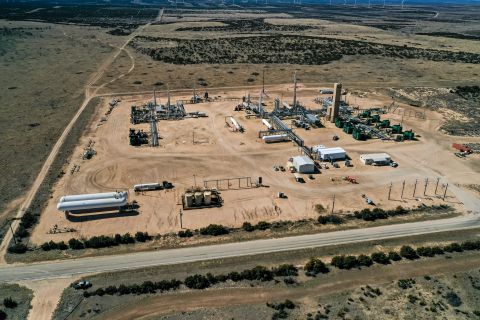
The Fayetteville shale play in northwestern Arkansas is far from mature, said Steven L. Mueller, president and chief operating officer of Southwestern Energy, in a presentation at Hart’s DUG conference in Fort Worth. “Pure development isn’t for another two years at least in this field,” he said.
Southwestern, which holds nearly 900,000 acres in the Fayetteville play, plans to run 15 horizontal rigs this year. Mueller said the firm will drill or participate in 600 wells, a 100-well increase from its 2008 activity.
Its plans for the Fayetteville are aggressive, because it needs to grow volumes tremendously to fill its pipeline space. The Houston-based company has two firm-capacity contracts, on the Boardwalk 36-inch line and the 42-inch Fayetteville Express.
Boardwalk’s first phase was finished at the close of 2008, and provided Southwestern with capacity of 350 million a day. Phase Two, a Mississippi River crossing, was put in service a week and a half ago. Southwestern has ramped up to 500 million a day, and this gas accesses Eastern markets and fetches Nymex plus 1 cent. Phase Three, a compression project, will be finished early next year. That will bring Southwestern’s capacity to 800 million a day, out the pipeline’s 1.3 billion cubic feet (Bcf) total.
The Fayetteville Express is in its early stages. Its first leg will go along the Boardwalk line’s right-of-way and also cross the Mississippi. When completed in 2012, it will be able to move 2.3 Bcf per day, and Southwestern’s share will be 1.2 Bcf. When both pipelines are in service, Southwestern will have contracts for 2 Bcf per day.
That’s far more than it produces today. In early 2006, it made less than 10 million a day from the shale; production is currently 750 million a day. To reach its committed volumes, it must grow volumes at 35% annually. “We’re about 40% of the way to hitting 2 Bcf in 2012,” said Mueller.
It will achieve this by drilling more wells, and by drilling better and cheaper wells. Southwestern has already raised per-well estimated ultimate recoveries to 3 Bcf on a 4,000-foot lateral, and it has dropped its drilling costs. Better flow rates and recoveries have come from increases in lateral lengths and sizes of fracture treatments, and decreases in costs have come from lower service prices and more efficient drilling.
The upshot: There are thousands of Fayetteville wells yet to drill.
Recommended Reading
Midstream M&A Adjusts After E&Ps’ Rampant Permian Consolidation
2024-10-18 - Scott Brown, CEO of the Midland Basin’s Canes Midstream, said he believes the Permian Basin still has plenty of runway for growth and development.
Post Oak-backed Quantent Closes Haynesville Deal in North Louisiana
2024-09-09 - Quantent Energy Partners’ initial Haynesville Shale acquisition comes as Post Oak Energy Capital closes an equity commitment for the E&P.
Analyst: Is Jerry Jones Making a Run to Take Comstock Private?
2024-09-20 - After buying more than 13.4 million Comstock shares in August, analysts wonder if Dallas Cowboys owner Jerry Jones might split the tackles and run downhill toward a go-private buyout of the Haynesville Shale gas producer.
Aethon, Murphy Refinance Debt as Fed Slashes Interest Rates
2024-09-20 - The E&Ps expect to issue new notes toward redeeming a combined $1.6 billion of existing debt, while the debt-pricing guide—the Fed funds rate—was cut on Sept. 18 from 5.5% to 5%.
Dividends Declared Sept.16 through Sept. 26
2024-09-27 - Here is a compilation of dividends declared from select upstream, midstream and service and supply companies.
Comments
Add new comment
This conversation is moderated according to Hart Energy community rules. Please read the rules before joining the discussion. If you’re experiencing any technical problems, please contact our customer care team.





